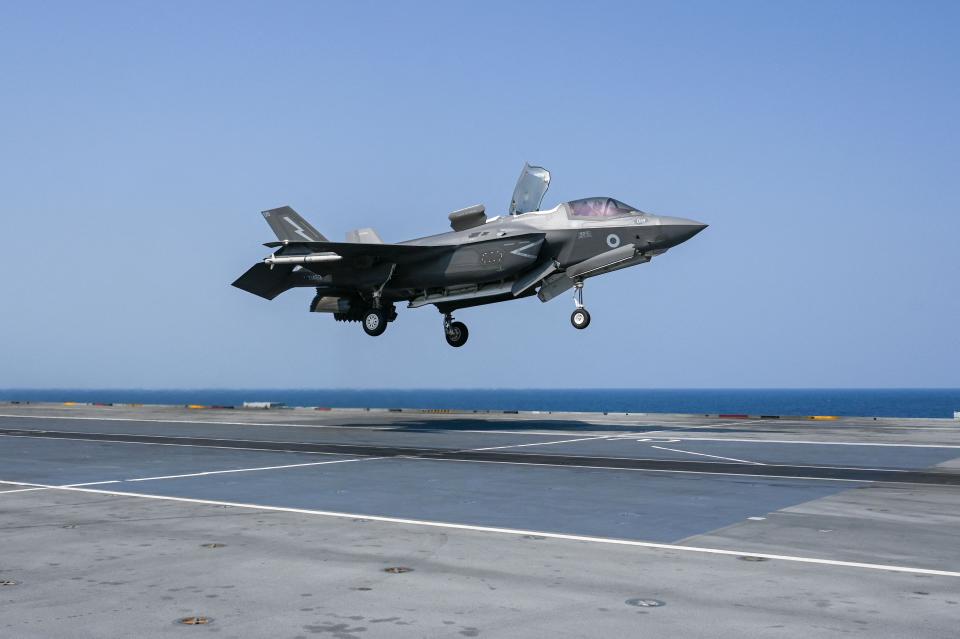An F-35B test plane crashed into a New Mexico hillside while flying from a Lockheed Martin facility to a US airbase

A new F-35B crashed in Albuquerque, New Mexico, on Tuesday, leaving its pilot injured.
The jet was a test model being transferred from a Lockheed Martin facility to the US military.
The F-35B is the Marine Corps' version designed for amphibious assault ships and short airfields.
A new F-35B Lightning II fighter jet crashed near the Albuquerque International Sunport in New Mexico on Tuesday, leaving its pilot seriously injured.
The aircraft crashed at 1:48pm. Fire rescue teams responded to the crash shortly after. Two other civilians on the scene were assessed for injuries and released.
On May 28 at 13:54 AFR, BCFR & Kirtland AFB responded to University south of Rio Bravo for a plane crash. BCFR and AFR’s Batt 1 confirmed a downed aircraft on fire. The pilot was located & transported while fire was extinguished. Scene has been turned over to Kirtland. pic.twitter.com/P0aaMvuod0
— Albuquerque Fire (@abqfire) May 29, 2024
The F-35 jet was traveling from the Lockheed Martin's facility at Naval Air Reserve Station in Fort Worth, Texas, to the Edwards Air Force Base in California. It stopped at Kirtland Air Force Base in New Mexico to refuel at 1:00pm, per Kirtland Public Affairs.
The pilot was transported to University of New Mexico hospital and is currently in stable condition.
About three hours after the crash, airport officials said flight operations had resumed. Videos shared on social media showed the crash, which appeared to have occurred during takeoff from the airport, as well as the aftermath of the incident, including fire rescue examining the scene on an Albuquerque hillside.
Last moments of F-35B fighter jet before it crashed at Albuquerque International Sunport. https://t.co/mdCjzUyywk pic.twitter.com/kN0i5mK5HU
— Clash Report (@clashreport) May 29, 2024
According to Lockheed Martin, the F-35B "was a US government-owned and-operated aircraft that was being flown by a government pilot who safely ejected. The aircraft was a test jet equipped with Technology Refresh 2 (TR-2) and was transferring for additional test equipment modification."
TR-2 is a version of the F-35's software. Lockheed Martin is currently troubleshooting issues from a TR-3 upgrade already installed in new jets as well as retrofitted in existing F-35s, which has delayed its further integration.
It's unclear what the program's goals for testing were, but developmental aircraft like this one are typically used to evaluate upgrades and other features.

This is the second F-35B mishap in less than a year. Back in September 2023, an F-35B pilot ejected during training while flying over South Carolina, landing in a residential neighborhood in North Charleston. The jet then went missing, continuing to fly about 80 miles before crashing.
That jet was also an F-35B, one of the three variants of the fifth-generation fighters. The F-35A is used by the Air Force, a major capability jump beyond its currently fielded F-16s and A-10s. The F-35C is used by the Navy, improving on other carrier-based aircraft like the F/A-18.
The F-35B is the Marine Corps' version, a short-takeoff/vertical landing variant specifically designed for amphibious assault ships and smaller airfields. The B variant costs about $100 million each. The entire decades-long F-35 program has an estimated life cycle cost of over $1.7 trillion, much of which will go to operating, maintaining, and repairing the jets.
Last September, a government watchdog reported that the F-35, which represents a "growing portion" of the Pentagon's tactical aviation fleet, was only mission capable half the time as of March 2023, "far below program goals."
Read the original article on Business Insider

 Yahoo News
Yahoo News 
